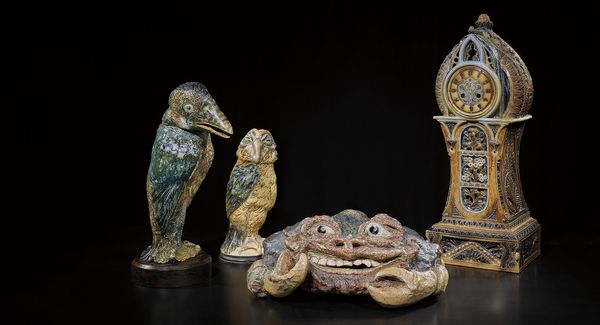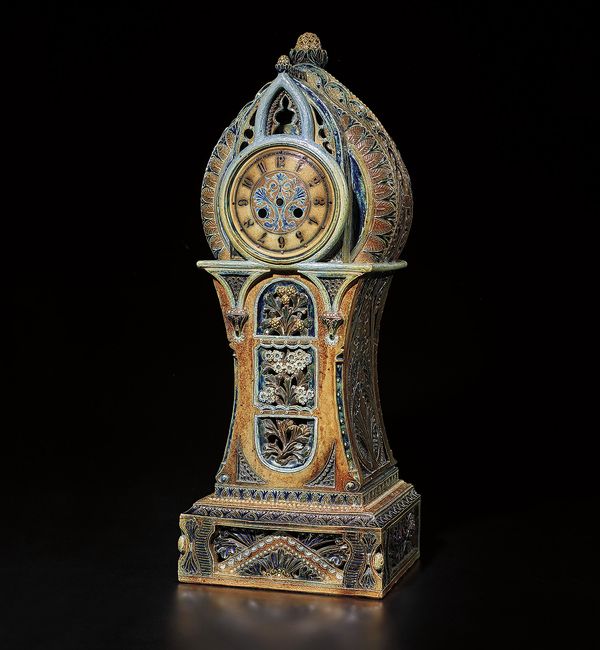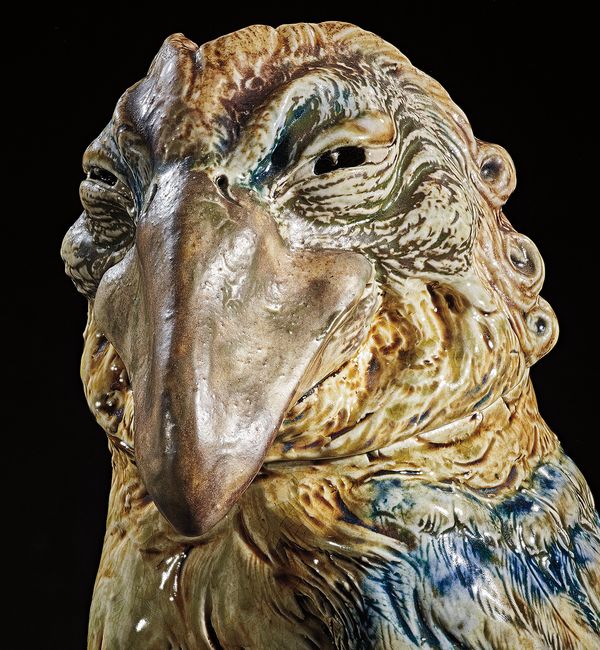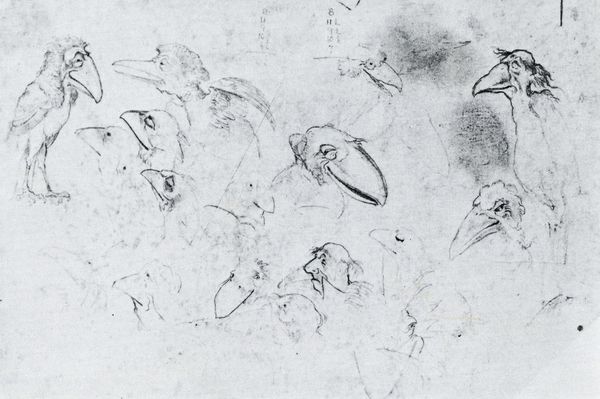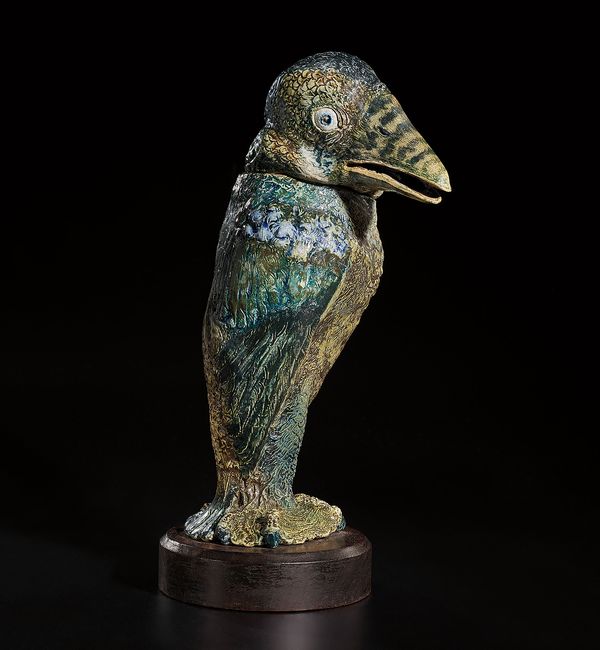A collection of four early, important masterworks by the Martin Brothers.
by Malcolm Haslam
All pieces of pottery made by the Martin brothers are distinctive, most are excellent, some outstanding. The four pieces on offer here are the crème de la crème. They all owe much of their brilliance to the genius of Robert Wallace Martin (1843-1924), the eldest of the four brothers, the founder of the pottery and an artistic talent to rival any other Victorian sculptor. His eccentric imagination, combined with mental determination and prodigious manual skill, created an œuvre which is awesome, both in its diversity and its intensity.
R.W. Martin & Brothers Exceptional and monumental mantel clock case, 1878
These four pieces represent a microcosm of that diversity. The clock case is architectural, a functional object, decorated with mostly flat pattern. Then there are the two birds, slyly humorous, pretending to be tobacco-jars but patently impractical as such. At several further degrees of remoteness from the utility of the clock case, comes the crab with a human face, a surreal monster which is totally nonfunctional, pure sculpture created to amuse but also to terrify. It is this diversity of style which has drawn in over the years so many collectors who themselves, perhaps, have only one thing in common—an aesthetic appreciation beyond the conventional.
Detail from R.W. Martin & Brothers Sir Edward George Clarke QC caricatured as a tall distinguished fantastical bird jar and cover, 1898
The intensity of Wallace's creations is revealed in each of these four pieces. A dramatic intensity is achieved not only through the sheer scale of the clock case but also through the density of its ornament. The bird made in 1883 also impresses through its size; it wears an expression so intensely human, yet remains so irrefutably avian, that one is forced to laugh without being quite sure what one is laughing at, which is the essence of true humor. The caricature of Sir Edward Clarke regards you with such an intensely inquisitorial eye that one feels oneself quaking in the witness box before a barrage of searching questions, only able to give a series of contradictory answers.
R.W. Martin & Brothers Colossal and extraordinary grotesque grinning crab, 1880
The crab is, quite simply, intensity itself, realized in stoneware; the reality of its intensity seems to be almost the only thing about the creature which is real. To create such a monster takes the extreme imagination that its maker possessed—or, rather, which possessed its maker.
Between them, the four pieces reveal two primary sources of influence which helped to mold Wallace's imagination. Like so many minds, then and now, his fell under the spell of Christopher Dresser's ideas. Wallace was precisely the sort of under-privileged art-worker at whom Dresser aimed his writings; Principles of Decorative Design (1873) was based on a series of lectures which Dresser had "prepared especially for those noble fellows who, through want of opportunity, have been without the advantages of education, but who have the praiseworthy courage to educate themselves in later life, when the value of knowledge has become apparent to them." He adopted two slogans, "Knowledge is Power" and "Truth, Beauty, Power," and his insistence on power as an important ingredient of art may well have helped to raise the level of intensity in Wallace's work. In Studies in Design (1874-1876), Dresser wrote: "The drawing of all grotesques must be vigorous and energetic.
Drawing from the Martin Brothers studio, circa 1895
"Grotesques must be expressed with such force and power as will give to them apparent reality, however impossible their formation may be." The significance of this passage to Wallace's grotesque animals and birds is clear, although his sculpted figures are very different to Dresser's two-dimensional designs, usually conceived in rational, geometrical terms.
R.W. Martin & Brothers Massive mendiculus aquatic bird jar and cover, 1883
Alongside Dresser's tenets, Wallace's mind held another artistic creed: a Ruskinian belief in nature and the art of the Middle Ages. This too had a profound influence on his imagination. He probably read much of John Ruskin's literary output as it was issued, but when he went to work as an assistant to the sculptor Alexander Munro in 1861 he might well have come face to face with the great man himself, who was godfather to one of Munro's children and a frequent visitor at the sculptor's studio in Buckingham Palace Road. Many other visitors called at the studio; Rossetti, Lewis Carroll and George MacDonald, the author of Phantastes (1858), were all intimate friends, and Edward Lear sometimes dropped by. How much of the medievalism and surreal humor which laced their talk was absorbed by Wallace can only be a matter of conjecture, but it was apparently enough to act as an antidote to Dresser's rationalistic formalism.
Adam Clay from Phillips Design narrates a selection from 'Jabberwocky', a poem by Lewis Carroll, who belonged to the same artistic circle as Wallace and his mentor Munro.
Robert Wallace Martin's pottery is a cocktail of these and probably other theories about art held by progressive Victorian thinkers. Somehow, into this mix was poured a large measure of religious fanaticism. The magnificent results of this alchemy can be seen in the diversity and intensity of the work which remains with us today to be cherished and enjoyed.
